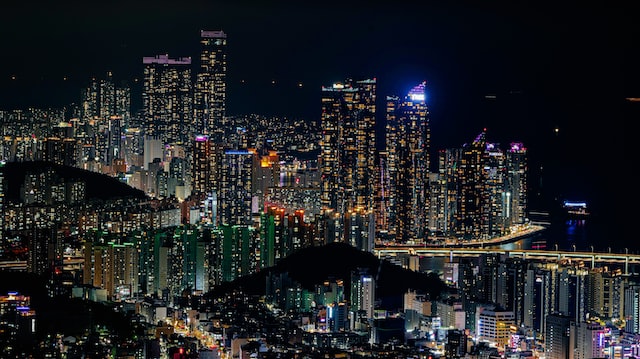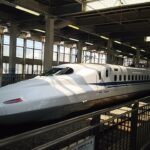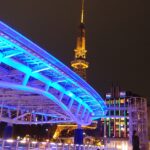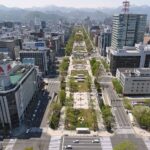Busan, South Korea, is a well-liked tourist resort with a robust public transportation network. The bus, which is run by the Busan Transportation Corporation, is the primary form of public transportation in Busan. In the city, there are more than 1,000 bus routes, making transportation simple. The city also has a subway system with five lines and a sophisticated tram system with three lines. Tourists will find Busan’s public transportation system to be dependable, inexpensive, and practical.
Basic information about the Metro system in Busan
In the South Korean city of Busan, there is a network of public transit called the Busan Metro. It has five lines that serve more than 160 stations, numbered 1, 2, 3, 4, and 6. The lines are connected by monorail, elevated, underground, and rail lines. The system is also connected to a number of bus lines as well as other rail networks, including the Busan-Gimhae Light Rail Transit. The system gives information about how it works in real-time and can be used by people with disabilities. The system works from 5:00 to 1:00, with longer hours on Saturdays, Sundays, and holidays. It is run by the Busan Transportation Company and is an important way for people to get around the city.
The lines of the busan subway system
Metro line 1 has 32 stations all along the line, including 11 underground and 21 elevated. There is a wide variety of services available on the route, including express, local, and shuttle services. Moreover, it offers a service that links the line with the Korea National Railroad network, enabling users to access adjacent cities.
Metro Line 2. The line connects Gwangalli Station in the south to Busan Station in the north. Along the way, it passes by a number of other well-known stations, including Busan Tower, Jungang Station, and Nampo Station. The line has 38 stops and more over 25 kilometers of track in total.
Busan, South Korea, and Gimhae are connected by Metro Line 3 of the city’s subway system. The first line of Busan’s new rapid transit system, which will have 11 lines by 2035, opened in October 2020. Gimhae International Airport and Ulsan Airport are Busan’s two main airports, and the new line, which connects them and gives access to the city’s key attractions, is 26.2 km long and contains 17 stations.
Metro Line 4 has 15 stations along the line, and each one has automated fare collection and ticket vending machines. A wide range of extra conveniences are also included, including free Wi-Fi, air conditioning, and CCTV cameras.
Metro Line 6 has 19 stations altogether, this light rail line travels from Busan Station in the east of the city to Oncheonjang Station in the west.
Map of Busan Metro 2023 – Free Download in PDF
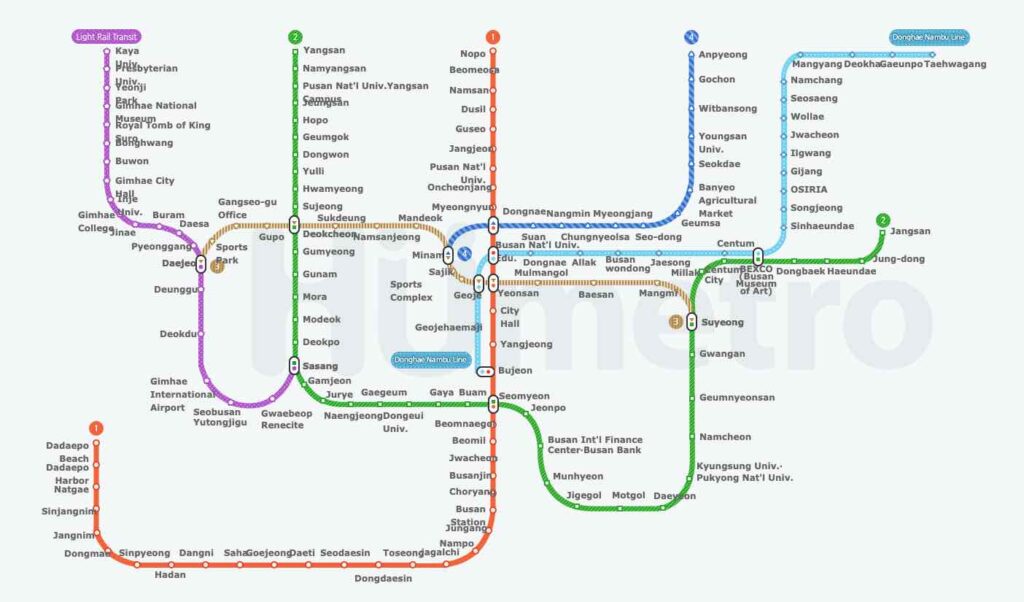
You can now download the Map of the Busan Metro 2023 for free in PDF format. This map will show you everything you need to know about the Busan Metro system, including all of the stations, lines, and routes. It will help both locals and visitors get around and understand the city’s public transportation system. This free download will help with travel planning and local knowledge while saving time, money, and hassle.
Public transport tickets in Busan – Best types for travelers & actual prices
Busan, a big city in South Korea, is known for its delicious food, rich culture, and easy-to-use public transportation. It is easy to navigate the city because of its robust train, bus, and metro systems. Below is an overview of the many ticket options, their costs, and other crucial details to make your trip even easier.
Bus and Metro tickets in Busan
The most widely used form of transportation in Busan is the Metro and Bus tickets. These tickets come in a variety of formats, including single-use, daily, and monthly passes.
- Single-use tickets cost 1,250 KRW and are only good for one trip (around 1 USD).
- Day passes are 4,000 KRW and provide access to unlimited rides for the day (around 3.50 USD).
- Monthly passes cost 40,000 KRW and are good for 30 days (around 35 USD).
Taxi tickets in Busan
Another well-liked method of transportation in Busan is the taxi, and rates differ depending on the time of day and distance traveled. Taxis cost 2,400 KRW (about 2 USD) at the beginning of the day and increase by 100 KRW (about 0.09 USD) for every 164 meters (around 0.1 miles). The starting fare increases by 200 KRW at night to 3,000 KRW (around 2.60 USD) (around 0.18 USD).
Train tickets for Busan
Another fantastic way to move rapidly through the city is to use the railway system. There are various types of tickets available, including single-use, daily, and monthly passes.
- Tickets for single use are 1,900 KRW (around 1.70 USD).
- Day permits are available for 5,500 KRW (about $4.90 USD) and allow for unlimited riding for the entire day.
- At 30,000 KRW (about $26.50 USD), monthly passes are good for one month of unrestricted rides.
Ferry tickets to Busan
The coastline of the city can be explored using the Busan Ferry.
- Tickets for single use are 3,500 KRW (around 3.10 USD).
- For 8,500 KRW (about $7.50 USD), day passes let you ride as many times as you want for the whole day.
- At 30,000 KRW (about $26.50 USD), monthly passes are good for one month of unrestricted rides.
It’s easy to move around Busan with ease because there are so many different kinds of tickets accessible. You can select the ideal ticket to suit your needs, whether you want to visit the city’s attractions or head to the beach for a day of relaxation.
Timetables & Schedules of Busan Metro system
From 5:30 in the morning until midnight, Monday through Saturday, and from 6:00 in the morning until midnight on Sundays and holidays, the Busan Metro system is open. During peak hours, trains run every three to four minutes, and during off-peak hours, they run every six to seven minutes. The Busan Metro system makes it quick and simple for passengers to navigate throughout the city. There are now 5 operating lines in the Busan Metro, and there are plans to add more lines. For visitors to Busan, the metro system is an excellent alternative because it makes it simple and quick to go about the city.
What Are Other Options For Public Transportation In busan?
Busan, South Korea, is a popular tourist destination, and public transit is a key factor. The metro system in the city makes it simple to go to numerous locations, but it might not be the ideal choice for everyone. Fortunately, Busan offers a variety of additional public transit choices, each with distinct benefits.
The hop-on, hop-off Busan City Tour Bus service is available every day from 8 a.m. to 8 p.m. All of the city’s key tourist destinations are covered by its ten routes, which are all air-conditioned and include free Wi-Fi. The Busan Tour Bus, which runs on two routes—the North Course and the South Course—is an additional choice. Tickets can be purchased on board, and it makes many stops at the city’s prime sights.
Finally, there are a number of ferry services that run from the Busan International Passenger Terminal for individuals who want to travel by water. Access to the surrounding islands of Geoje, Yeosu, and Ulleungdo is made possible by these services.
There are many different kinds of public transportation in Busan that can meet the needs of any kind of traveler. There is likely to be something that suits your needs, whether you’re searching for an efficient way to move around or a cheap way to experience the city.
How To Get From GIMHAE INTERNATIONAL AIRPORT (pus) To The City Center With Public Transport?
A significant entry point to the South Korean city of Busan is the Gimhae International Airport. There are various options for public transportation for individuals wishing to get from the airport to the city center.
Take a shuttle bus from the airport to the city center as your first choice. It takes roughly 45 minutes for the shuttle bus to travel between the airport and the downtown area. From 5:30 am to 10:30 night, it operates every 20 minutes for just 2,500 won ($2.25 USD).
The airport rail is a fantastic choice for people looking for a quicker option. The airport railway takes around 30 minutes to travel from the airport to the city center and only costs 4,000 won (about $3.60 USD). Between 5:30 a.m. and 10:30 p.m., the railway operates.
Taxis are also an alternative for individuals seeking a more direct route. You may catch a taxi at any time of day or night, and it takes about 25 minutes to go to the city center. Depending on the time of day and the volume of traffic, a cab might cost between 10,000 and 15,000 won (about $9 and $13 USD).
Local buses also travel from the airport to the city center for those seeking a more economical option. The local buses cost only 1,200 won (approximately $1 USD) and run from 5:30 am to 11:30 pm. The trip is a wonderful choice for individuals on a budget and lasts around an hour.
Whatever route you take, it is simple and convenient to go from Gimhae International Airport to the city center. With so many choices, you can choose the one that best fits your financial situation and time limits.
What kind of sightseeing DO you have to see if you visit Busan for the first time?
- Haeundae Beach: One of Korea’s most well-known beaches, Haeundae Beach is a terrific place to unwind and have a good time. It is understandable why this beach attracts so many tourists each year given its beautiful sand and crystal-clear waters.
- Gwangalli Beach: Another excellent beach in Busan is Gwangalli Beach. It is renowned for its breathtaking views of the Gwangan Bridge at night when it is illuminated in vivid hues.
- Jagalchi Fish Market: The largest seafood marketplace in South Korea is located in Jagalchi Fish Market. Fresh fish is readily available for purchase, including mackerel, squid, and crab.
- Gamcheon Cultural Village: Situated on the southern slopes of Busan, Gamcheon Culture Village is a distinctive village. It is a beautiful spot to explore and take in the creative vibe because it is full with vibrant houses and art installations.
- Taejongdae Resort Park: Situated on Yeongdo Island’s cliffs, Taejongdae Resort Park is a picturesque park. It provides breathtaking views of the sea and the surrounding islands. The park’s pathways, which are surrounded by wildflowers and pine trees, are also open to visitors.
Summary of our tour guide for Busan
A significant port city, Busan is located in South Korea’s southeast. With 3.6 million residents, it is the second most populous city in the nation. There is something for everyone in the dynamic and vivacious city of Busan. It has a lot of cultural attractions, lively nightlife, beautiful beaches, and a lot of places to shop. Busan’s public transportation is very good, and the Busan Metro makes it easy to get to all the main sights. Also, there is a vast network of buses and taxis that can transport people anywhere they need to go.
Top 5 FAQs and answers about Busan public transport?
- What kind of public transportation is offered in Busan?
- Buses, metro lines, and ferries are all a part of Busan’s comprehensive public transportation network. With more than 1,500 routes connecting the city, buses are the primary mode of transportation. The Busan-Gimhae Light Rail Transit, the newest of the six lines in the subway system, connects the two cities. The ferry system connects Busan with other significant South Korean cities and is used for both domestic and international travel.
- How much does using public transportation in Busan cost?
- Depending on the mode of transportation and the distance traveled, public transportation in Busan has different prices. A single journey on the subway costs 1,350 won ($1.19 USD), whereas a single bus ticket costs 1,200 won ($1.06). Ferries cost between 8,000 won ($7.03) for a short trip and 10,000 won ($8.79) for trips to foreign cities.
- How can I pay for public transportation in Busan in the simplest way possible?
- Using a T-money card is the most practical way to pay for public transportation in Busan. T-money cards, which function similarly to debit cards, can be used to pay for all types of citywide public transportation. The cards are available for purchase online, at ticket offices, and convenience stores.
- What are the busan public transportation’s hours of operation?
- Depending on the kind of transit, the public transportation in Busan has different operation hours. While the subway operates from 5:30 am to 1:00 am, buses operate from 5:30 am to midnight. Operating hours for the ferry system are 8:00 am – 8:00 pm.
- How can I find the most recent information on Busan’s public transportation?
- Using the Busan Transportation Company website is the most effective approach to find the most recent information on public transportation in Busan. The website offers details on bus schedules, prices, and operating times. You can also download a smartphone app to check schedules and make travel arrangements.
Useful links

